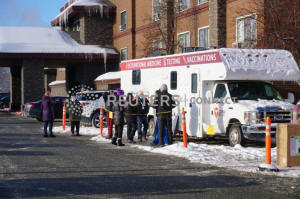Alaska's Iditarod sled dog race is on, with COVID-19-altered course
 Send a link to a friend
Send a link to a friend
 [March 05, 2021]
By Yereth Rosen [March 05, 2021]
By Yereth Rosen
ANCHORAGE, Alaska (Reuters) - The word
"Iditarod" derives from an indigenous Alaskan name for a "far
distant place." Due to precautions made necessary by the COVID-19
pandemic, this year’s Iditarod Trail Sled Dog Race, which starts on
Sunday, will be an especially distanced event.
The trail for the world’s most famous sled dog race has been
drastically rerouted to avoid almost all the communities that
normally serve as checkpoints, and the traditional ceremonial start
in Anchorage has been eliminated.
Only 47 mushers and their dogs have entered, a much smaller field
than usual, as many mushers were unable to clear coronavirus-related
travel obstacles. And there will be almost no spectators cheering
teams on in person, as trail access will be strictly limited.
Once mushers and their dogs take off, however, a lot will be back to
normal for them, said 2018 champion Joar Leifseth Ulsom, one of this
year’s favorites.
“It’s not like we are very social people. We spend most of our time
out with the dogs,” Leifseth Ulsom, a Norwegian who lives full-time
in Alaska, told Reuters.

COVID-19 planning for this year’s race started at the end of last
year’s contest, when participants came home “to a different world,”
said Rod Urbach, the Iditarod’s chief executive.
Canceling was not an option, Urbach said. Instead, the Iditarod
created a "robust" COVID plan that, as of this week, had been
updated 21 times, he said.
The biggest change for this year's 49th edition of the race is the
course. Instead of running to Nome, the Bering Sea town that is
normally the finish line, the 2021 route will be an out-and-back
loop taking teams to an uninhabited checkpoint called Iditarod and
the abandoned mining settlement of Flat, then back to the starting
point in Willow, about 75 miles (121 km) north of Anchorage. The
total distance is about 860 miles, roughly 100 miles shorter than
the traditional course.
All participants must test for COVID repeatedly and remain in an
Iditarod "bubble," Urbach said. That’s especially important for race
officials, veterinarians and volunteers who far outnumber the
competitors, he said.
[to top of second column] |

Support workers for the
Iditarod Trail Sled Dog Race line up outside the Lakefront Anchorage
Hotel, the site of the temporary Anchorage Iditarod headquarters, to
be tested for coronavirus (COVID-19), in Anchorage, Alaska, U.S.,
March 4, 2021. The workers are not allowed in the hotel until they
are screened, according to the race's 2021 rules. REUTERS/Yereth
Rosen

“The mushers are fairly easy to socially distance,” he said.
Coronavirus aside, this year’s field is highly competitive, Leifseth
Ulsom said. He is one of four returning champions, a group that
includes four-time winners Dallas Seavey and Martin Buser, and 2019
champion Pete Kaiser.
Also expected to compete are the Iditarod’s top women - Aliy Zirkle,
planning to retire after this year’s race, and Jessie Royer, who
finished third the past two years.
Plentiful snow this season has allowed for ample advance training,
Leifseth Ulsom said. “We’ve had a really good winter, the best we’ve
had in a long time,” he said.
The Iditarod, as it has every year, faces criticism from
animal-rights activists condemning the event as cruel to dogs,
putting pressure on race sponsors. In January, Exxon Mobil announced
it was ending its longtime sponsorship after this year’s race.
Urbach said the Iditarod has, nevertheless, gained some new sponsors
and is drawing revenue from a subscription service that sends video
directly to fans.
Plans are already underway for next year’s 50th anniversary
Iditarod, which is expected to be conducted in a post-COVID world,
Urbach said.
“Next year, we’re going to have the biggest bash in Anchorage
imaginable,” he said.

(Reporting by Yereth Rosen in Anchorage, Alaska; Editing by Steve
Gorman and Stephen Coates)
[© 2021 Thomson Reuters. All rights
reserved.] Copyright 2021 Reuters. All rights reserved. This material may not be published,
broadcast, rewritten or redistributed.
Thompson Reuters is solely responsible for this content. |